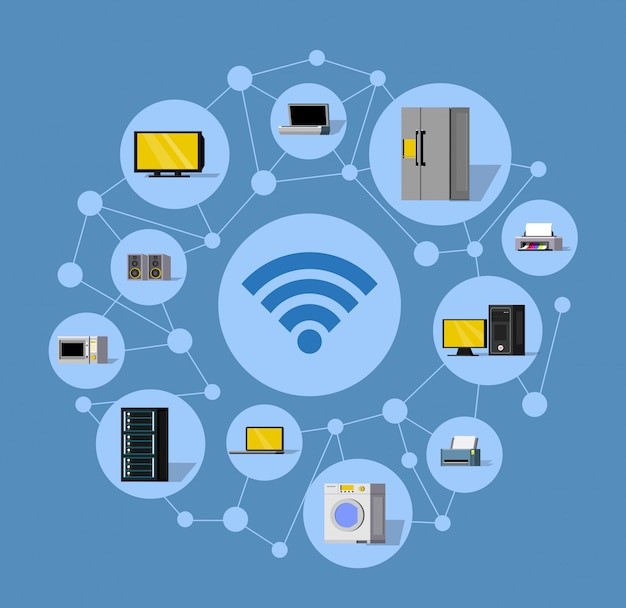Wireless Networks – The Main Problems and How to Avoid Them

If you’re a business owner, chances are that wireless network solutions have crossed your mind while planning out the infrastructure for your company. A wireless network is invaluable for allowing employees to stay connected and work from anywhere, yet it can create some major headaches when setup improperly or inadequately secured. Today, we’re discussing some of the main problems associated with wireless networks and what steps you should take to avoid them. Whether you already have a functioning system or are in the process of researching different possibilities, this post will provide insight into potential issues before they become roadblocks down the line. Let’s dive right into it!
Identify the most common wireless network problems, such as interference, limited coverage, and slow speeds
Wireless networks have become an integral part of our lives, providing quick and easy access to the internet. However, they are not without their problems, and there are a few common issues that many people encounter. Interference is one of the most frustrating problems which can disrupt the signal from your wireless router, leading to a drop in speed or even disconnection. Limited coverage is another common issue that can occur due to the building materials in your home or office, which can obstruct the wireless signal. Slow speeds can also be a huge inconvenience, especially when you need to download or upload large files. Fortunately, there are wireless network solutions available to help overcome these issues, such as choosing the optimal channel, investing in a range extender, and using a mesh network to provide a wider coverage area. With these solutions, you can ensure a faster and more reliable wireless connection.
Explain why a wired network is a better option for those who need more bandwidth and speed
A wired network offers many advantages to those who require higher levels of bandwidth and speed. While wireless network solutions are convenient and easy, they simply cannot compete with the speed and reliability of a wired network. Wired networks offer a direct connection to the internet or local network, resulting in faster download and upload speeds. Additionally, wired networks are less susceptible to interference and are more secure than wireless networks. If your business depends on fast, uninterrupted connectivity, a wired network is the smart choice.
Explore the various types of wireless network hardware available and the pros and cons of each
In today’s tech-powered world, wireless network solutions have become a necessity. With the emergence of smart homes, IoT devices, and remote work, wireless network hardware has become a significant component of our lives. There are various types of wireless network hardware available, ranging from Wi-Fi routers, wireless range extenders to mesh Wi-Fi systems. Each of these solutions comes with its set of pros and cons, and choosing the right one can be a tricky process. However, spending time to explore the options thoroughly can significantly improve your home network’s performance and ensure that you stay connected, no matter where you are in your house.
Discuss how to improve your home or office’s wireless signal with proper placement of routers and antennas
Are you tired of having a weak wireless signal at home or in the office? Luckily, there are wireless network solutions that can improve your connection without having to call in a professional. Proper placement of routers and antennas can significantly enhance your signal strength. Routers should be placed in a central location, away from walls and obstructions, and antennas should be positioned vertically to maximize their reach. Additionally, it is important to consider the layout of your space and adjust the orientation of your router and antennas accordingly. With these simple tips, you can enjoy a faster and more reliable wireless connection.
Highlight some of the best practices for setting up a secure wireless network
In the modern age of technology, having a secure wireless network is essential. To ensure your data remains safe, it’s important to set up your wireless network with the best practices in mind. One of the key things you can do is to use modern wireless network solutions that have built-in security features. This can range from using WPA2 encryption to segregating your network through VLANs. Other best practices include changing default passwords, implementing strong passwords, and regularly updating and patching your system. With these measures in place, you can ensure that your wireless network is secure and your data remains safe from potential threats.
Provide tips on how to best troubleshoot any issues that may arise with your home or office’s wireless network
In today’s fast-paced world, having a reliable wireless network has become a necessity for most homes and offices. However, it’s not uncommon to face issues with your connection, and troubleshooting them can be frustrating, to say the least. To avoid any inconveniences and resolve any issues efficiently, consider implementing a few wireless network solutions. Firstly, reset your network devices, including your modem, router, and computer. Also, ensure that all your devices are compatible with your wireless network and that your network is secured with a strong password. Lastly, update your network’s firmware regularly and position your router in a central location. By implementing these simple tips, you can avoid network issues and enjoy uninterrupted internet access.
In conclusion, wireless networks are a great way for most people to connect to the internet, but there are still some common issues such as interference, limited coverage, and slow speeds that must be addressed. A wired network is always a better option for those who need more reliable bandwidth and speed. Exploring the various types of wireless network hardware available and understanding their advantages and disadvantages is important before making a decision. Additionally, proper placement of routers and antennas can also significantly improve your home or office’s wireless signal. Lastly, making sure that your network is secure along with following best practices for troubleshooting any issues will help make sure that you get the most out of your wireless network solutions.
The Various Aspects of Property Management

Do you own rental property? Have you ever wondered what it takes to manage a real estate portfolio? Being the owner of rental property can be both rewarding and challenging. This blog post will explain some of the many aspects involved in managing a property effectively, from finding qualified tenants to making sure that all legal requirements are met – so that your investment not only remains secure but also profitable.
Exploring Different Types of Property and Their Management Needs
The world of property management is vast and varied, encompassing everything from residential homes to commercial buildings and beyond. Each type of property requires unique management needs in order to ensure that they are running smoothly and efficiently. This is where property manager software comes in handy, providing property managers with the tools they need to streamline their operations and keep everything organized. Whether you’re managing a portfolio of rental properties or a large commercial building, having the right software in place can make all the difference. By exploring the different types of property and their management needs, property managers can ensure that they are using the most effective tools and strategies for success.
Understanding the Roles and Responsibilities of a Property Manager
A property manager plays a critical role in maintaining and enhancing the value of a real estate investment. From marketing and leasing to budgeting and maintenance, they are responsible for overseeing all aspects of a property. Property manager software has become an essential tool for streamlining these activities, making them more efficient and effective. With features such as automated rent payments and maintenance requests, property manager software allows managers to focus on the strategic tasks that are essential to long-term success. Whether it’s managing a single property or a portfolio of assets, property managers who leverage these innovative tools are better equipped to deliver exceptional results for their clients and tenants.
Setting Clear Goals and Objectives to Achieve Optimal Performance
As a property manager, achieving optimal performance can often feel like a daunting task. However, setting clear goals and objectives can make a world of difference. Not only does this help you identify what you want to accomplish, but it also helps you track your progress along the way. And with the right tools, achieving these goals has never been easier. Property manager software is a valuable resource that can help you streamline your processes, track your progress, and ultimately achieve the best possible results. With a clear roadmap to success and the right tools in your arsenal, nothing can stand in your way.
Analyzing the Financial Aspect of Property Management
When it comes to property management, analyzing the financial aspect is crucial for success. It is important to keep track of income and expenses, budget accordingly, and ensure that finances are being managed efficiently. One way to accomplish this is through the use of property manager software. This technology can assist property managers in organizing financial data such as rent collection, vendor bills, and maintenance costs. With this information in a central location, property managers can easily monitor finances and make informed decisions. By utilizing property manager software, property managers can ensure that they are on top of their finances and keeping their properties profitable.
The Benefits of Working with Professional Property Managers
Investing in real estate can be lucrative, but it comes with its fair share of challenges. One of the smartest decisions a landlord can make is to work with a professional property manager. Doing so can alleviate the burden of day-to-day tasks such as rent collection, tenant screening, and maintenance requests. Additionally, property managers have access to advanced software that can streamline processes and provide real-time updates to both landlords and tenants. This software allows property managers to keep detailed records and stay on top of payments and maintenance needs. By investing in a property manager, landlords can benefit from their professionalism, experience, and access to innovative technology, saving them time and money in the long run.
Keeping Track of Laws and Regulations Governing Real Estate Property Management
Managing real estate properties can be a daunting task, especially when it comes to keeping up with the ever-changing laws and regulations. With so many policies to consider, it’s easy to feel overwhelmed and unsure if you’re meeting all the necessary requirements. Fortunately, property manager software can alleviate some of the stress associated with staying up-to-date. These programs are designed to automatically track and monitor changes in laws and regulations, ensuring that property managers are always informed and compliant. By utilizing these tools, property managers can focus on more important tasks, like providing excellent customer service and maintaining a safe and secure living environment for tenants.
As you can see, there are vastly different types of property and each has different needs in terms of management. It is important to take the time to understand the roles and responsibilities of property managers, set clear goals and objectives in order to achieve optimal performance, analyze the financial aspects of property management, and work with professional property manager whenever possible. In addition, keeping track of the laws and regulations governing real estate property management is a critical component as well. Property managers have an important job helping us manage our investments. Investing in proper training for staff and utilizing modern technology like property manager software can help ensure that buildings are run efficiently for years to come. Ultimately having the right resources on hand means being able to make long-term plans for any rental units or commercial properties held under your investment portfolio. Taking these steps will lead towards a profitable future.
How a Point of Sales System Can Streamline Operations in Your Restaurant?
Are you the owner of a restaurant looking to make your operations more efficient? Investing in a Point of Sales (POS) system could be world-changing for your business. With technology advancing rapidly, replacing manual processes with digital tools is one of the best ways to improve management in restaurants and ensure customer satisfaction remains high. In this blog post, we’ll discuss how a POS system can help streamline operations and assist other areas within your foodservice business. From increasing security against online threats to improving cash handling techniques, there are many advantages that are worth considering when it comes time to invest in technology. So keep reading to learn more about why investing in a POS system could benefit your restaurant now and into the future!
Introduce the Benefits of Having a Point of Sale System in Your Restaurant
As a restaurant owner or manager, you’re always on the lookout for ways to make your operations run more smoothly. That’s where a point of sale (POS) system comes in. By incorporating this technology into your business, you’ll be able to improve your daily workflow, increase efficiency, and even boost your bottom line. A POS system is essentially a one-stop payment and order processing center that streamlines transactions, eliminates the need for handwritten receipts, and offers valuable insights into your business’s daily operations. This technology also allows for faster, more accurate order-taking and payment processing, so your staff can focus on providing top-notch customer service. With a POS system for your restaurant, you’ll enhance the overall dining experience for your customers while improving your own business operations.
Explore the Types of POS Systems Available for Restaurants
In today’s fast-paced world, a point of sales system for restaurant is an essential aspect of any eatery’s smooth functioning. With the rise of technology, there are now a number of different POS systems available that cater to every need. From cloud-based systems that offer mobility and flexibility to traditional on-premise servers that offer robust security, the types of POS systems for restaurants are vast and it can be tough to choose the best one for your business. It’s important to consider factors like budget, restaurant type, and scalability before making a decision. So, whether you’re a small mom-and-pop diner or a booming chain restaurant, there’s a POS system out there that will help you take your business to the next level.
Discuss the Different Features and Functions of a POS System
In today’s restaurant industry, Point of Sales (POS) systems are essential for efficient and effective operations. With constantly evolving technology, these systems offer a range of features and functions that meet the operational and financial needs of restaurants. They allow for accurate and seamless ordering with the ability to customize orders, apply discounts and promotions to orders, and track inventory management. POS systems also help with employee management through timekeeping and schedule management, while giving managers the ability to track sales data in real time. The advantages the POS system brings to restaurants are too numerous to count, making it an integral tool in the modern restaurant industry.
Analyze How a POS System Can Improve Restaurant Operations
A point of sales system for a restaurant can bring about a vast improvement in the entire operations of the establishment. Gone are the days when restaurants used good old pen and paper to manage orders, inventory, and daily sales. With a POS system, restaurants can now accurately monitor inventory, sales, and customer experience. This technology allows restaurants to input and track everything from customer orders to employee hours, plus many more aspects of the business that can be difficult to keep track of. As a result, restaurant owners and managers can analyze sales trends and make informed decisions about menu offerings, staffing, and more. By streamlining your restaurant’s operations with a point of sales system, you can focus more on the quality of food and service, and less on the logistical headaches that come with running a restaurant without such a system.
Examine Ways to Utilize Your POS System To Increase Profits
As businesses strive to remain competitive, they often turn to technology for help. One such technology that has become essential for restaurants is the point of sales (POS) system. Not only does it simplify the ordering and payment process, but it can also provide valuable data that can be used to increase profits. By examining ways to utilize your POS system, such as tracking sales trends, optimizing menu pricing, and leveraging customer loyalty programs, you can make data-driven decisions to boost revenue. Let your POS system do the heavy lifting and watch your profits grow.
Identify Strategies for Setting Up and Training Employees on a Point Of Sale System
When it comes to running a restaurant, a point of sale (POS) system is essential for keeping operations running smoothly and efficiently. But setting up and training employees on this system can sometimes be a challenge. To address this, there are a few key strategies that managers can use to ensure a successful implementation. First, it’s important to select a user-friendly system that’s easy for both employees and customers to navigate. Next, managers should provide thorough training to all staff members, including hands-on practice and prompt feedback. Finally, it’s a good idea to assign a dedicated employee to act as an in-house POS expert who can troubleshoot issues and offer ongoing support. By following these strategies, restaurant owners can be sure their POS system is being used to its fullest potential.
As we have seen, the benefits of having a point of sale system for restaurant operations are vast. POS systems streamline customers’ checkout process, provide easier access to customer data, and allow for real-time analysis and reporting. In addition, these systems can track inventory with ease and enhance order accuracy; this greatly enhances restaurant operations as you’ll be able to optimize the delivery of orders. Moreover, decisions related to promotions or discounts can be made quickly and efficiently thanks to POS. Lastly, proper implementation requires training employees on the system and dedication to setting up your software properly to maximize your profits. All in all, using a point of sales system for a restaurant provides an array of advantages that any business should take advantage of in order to maximize efficiency and profitability. With the right strategies in place, any restaurant operator can benefit from having a POS system. Hoping this post has given you insight into how utilizing a POS system effectively is key for successful restaurant management, so why not invest in one today?
Solutions Offered by Managed IT Services

Do you feel like the workload of managing the IT infrastructure of your business is slowing down productivity? Do you struggle to keep up with the ever changing technologies and cybersecurity landscape? If so, a managed IT service provider can help lighten your load. By leveraging experienced engineers and operational processes developed over years of client engagements, they offer cost-effective solutions that can optimize existing platforms for greater efficiency or provide an entirely new technology strategy tailored to meet organizational objectives. Read on to learn more about how managed IT services can reduce stress while delivering valuable results for your business.
What are Managed IT Services and how can they benefit your business
In today’s digital age, technology plays a critical role in the success of business operations. However, managing an organization’s technology infrastructure can be complex and time-consuming for in-house IT teams. This is where managed IT services come in. Managed IT services in San Fernando Valley provide businesses with access to a team of experts who take care of their technology needs. From cybersecurity to software updates and maintenance, managed IT services ensure that an organization’s technology infrastructure is always up-to-date and secure. This enables businesses to focus on their core competencies, rather than spending time and resources on managing their IT infrastructure. With managed IT services, businesses can improve efficiency, reduce downtime and boost productivity.
Benefits of 24/7 monitoring and proactive maintenance
When it comes to managing your IT infrastructure, there’s no doubt that having 24/7 monitoring and proactive maintenance is essential. That’s where managed IT services in San Fernando Valley come in. With this kind of support, you can rest easy knowing that any potential issues are being addressed before they even become a problem. This level of monitoring ensures that your systems are always running efficiently and effectively, minimizing downtime and maximizing productivity. So whether you’re a small business owner or part of a larger organization, investing in managed IT services can provide you with the peace of mind you need to focus on what really matters: growing your business.
Improved security measures to protect data and systems from malicious attacks
In today’s digital landscape, businesses face an ever-growing number of threats aimed at compromising their data and systems. That’s why it’s crucial to implement improved security measures to protect against these malicious attacks. One way businesses can strengthen their security is by partnering with managed IT services in San Fernando Valley. Managed IT services can offer comprehensive security solutions, from identifying vulnerabilities and assessing risk to designing and implementing customized security protocols. With the right security measures in place, businesses can rest assured that their valuable data and systems are protected from even the most determined cybercriminals.
Implementing the right technology for your business needs
In today’s digital age, having the right technology is crucial for the smooth functioning of any business. However, finding and implementing the ideal technology can be a daunting task, especially if you’re not an IT expert yourself. That’s where managed IT services in San Fernando Valley come into play. With tailored solutions that cater to your specific business needs, these professional services can help you implement the right technology – be it hardware, software, or cloud-based solutions – that can help streamline your operations and boost productivity. By outsourcing your IT needs to trusted managed services providers, you can focus on your core business tasks and leave the technological aspect in safe hands.
Flexible IT solutions tailored for businesses of all sizes
In today’s fast-paced business landscape, having an IT infrastructure that is agile and scalable is essential for companies of all sizes. That’s why it’s so important to partner with a reliable provider of managed IT services in San Fernando Valley that can offer flexible solutions that can be tailored to fit your unique needs. Whether you’re a startup, a small business, or a large enterprise, having the right IT support can make a real difference in terms of competitiveness, productivity, and profitability. With customizable solutions, you’ll get the support and resources you need, without having to worry about overspending or underutilizing services. So why not explore your options today and see how a trusted IT service provider can help your business succeed?
How managed IT services can help reduce costs and improve efficiency
In today’s digital age, businesses of all sizes depend heavily on technology to run their daily operations. However, managing and maintaining IT infrastructure can be challenging, time-consuming, and expensive. This is where managed IT services come in. By outsourcing IT tasks to a company that specializes in providing such services in San Fernando Valley, businesses can significantly reduce costs and improve efficiency. These services include monitoring and maintaining networks, updating software and hardware, backing up data, and providing tech support to employees. As a result, business owners and their staff can focus on what they do best- running their business- and leave IT-related tasks to the experts. Plus, with the latest technologies and tools at their disposal, managed IT service providers can ensure businesses stay secure, productive, and competitive.
Managed IT services are essential for businesses of all sizes, no matter what sector you’re in. Business owners need to stay ahead of the competition by being proactive with their business’s IT needs and backing up data regularly. When it comes to choosing a managed IT services provider, look no further than the experts in San Fernando Valley. With 24/7 monitoring, improved security measures, flexible IT solutions tailored specifically for your business needs, and reduced costs from managed IT services, you’ll be able to save time and money while getting the most out of your existing technology stack. Investing in managed IT services removes some of the complexities of keeping up with technology and allows you to run a reliable and secure operation. So if you have serious goals for growth this year and want to take full advantage of the latest trends in tech, there’s no better time than now to get started with managed IT services in San Fernando Valley! Click here to learn more details.
How Does Cloud Infrastructure Enable Greater Business Continuity?
As a business owner, you know that ensuring continuity is one of the keys to success. But how can you guarantee that your operations will continue without disruption when technology keeps evolving? The answer lies in knowing and making the most of cloud infrastructure. By leveraging the capabilities offered by cloud technology, businesses can benefit from greater resilience and flexibility while controlling their costs—ultimately leading to higher levels of reliability and increased productivity. In this guest post, we’ll explore how cloud infrastructure-based solutions deliver scalable performance for optimal business continuity.
Introduce the concept of cloud infrastructure for businesses
As businesses continue to operate in a digital landscape, the need for reliable and scalable infrastructure has become crucial. That’s where cloud infrastructure comes in. Simply put, cloud infrastructure refers to the on-demand computing resources, such as servers, storage, and applications, that are delivered over the Internet. This type of infrastructure is known for its flexibility, cost-effectiveness, and ease of use. With cloud infrastructure, businesses can easily access and scale up or down their IT needs depending on their business demands. It takes away the burden of having to manage and maintain hardware and enables businesses to focus on driving innovation and growth. It’s no wonder why so many businesses are turning to cloud infrastructure as a fundamental part of their digital strategy.
Explain the benefits of cloud infrastructure for business continuity
The advantages of utilizing cloud infrastructure for business continuity are abundant and noteworthy. One of the most significant benefits is the ability to operate remotely, which removes the need for a physical office and allows for work to continue even in the face of disruptions such as weather events, power outages, or other unforeseen circumstances. Additionally, cloud infrastructure provides the flexibility and scalability necessary to quickly adapt to shifting business needs. With automatic backups and constant monitoring, businesses can be confident that important data and applications are secure and accessible at all times. Cloud infrastructure also allows businesses to save on costs related to hardware and maintenance. Overall, implementing cloud infrastructure for business continuity purposes is a smart move that can streamline operations and provide peace of mind.
Outline the different types of cloud infrastructure available
In today’s technology-driven world, cloud infrastructure has become a veritable necessity for businesses of all sizes. With its flexibility, ease of use, and affordability, cloud computing has become the go-to solution for companies looking to streamline their operations and stay ahead of the curve. When it comes to cloud infrastructure, there are several different options available. One of the most popular is public cloud infrastructure, which is hosted by third-party providers such as Amazon Web Services (AWS), Microsoft Azure, and Google Cloud Platform. Another option is private cloud infrastructure, which is built and managed internally by the organization. Additionally, hybrid clouds, which combine elements of both public and private clouds, have become increasingly popular in recent years. Each of these options offers its own set of advantages and disadvantages, and it’s up to each organization to determine which one is best suited to their specific needs and goals.
Explain how cloud computing can improve scalability and flexibility
In today’s fast-paced business world, companies must have the ability to quickly adapt to changing market demands. Cloud computing provides businesses with the scalability and flexibility needed to do just that. With cloud computing, businesses can quickly and easily scale up or down their resources as needed, without the need for costly infrastructure investments. Additionally, cloud computing provides businesses with the ability to access their data and applications from anywhere, at any time, making it easier for remote workers to collaborate and stay productive. Whether you’re a small start-up or a large enterprise, cloud computing can provide the tools you need to succeed in today’s competitive business landscape.
Discuss how cloud infrastructure can help reduce costs and increase efficiency
In today’s fast-paced world, businesses are always on the lookout for ways to streamline their operations and cut costs. One solution that has become increasingly popular is cloud infrastructure. By moving their data and applications to the cloud, businesses can reduce the need for expensive on-premises hardware and software, while also taking advantage of the scalability and flexibility that the cloud offers. Cloud infrastructure can help increase efficiency by allowing employees to access data and work from anywhere, on any device. With the cloud, businesses don’t need to worry about maintaining and updating their infrastructure – it’s all taken care of by the cloud provider. By embracing cloud infrastructure, businesses can focus on what they do best – serving their customers and growing their business.
Give examples of best practices for implementing and managing a cloud infrastructure
In today’s digital age, cloud infrastructure has become an integral part of every organization’s IT strategy. However, implementing and managing cloud infrastructure is no easy task. It requires careful planning, proper execution, and constant monitoring to ensure optimal performance. Best practices for cloud infrastructure implementation and management include choosing the right cloud provider, identifying the key performance indicators (KPIs) for measuring success, establishing clear security protocols, creating backup and disaster recovery plans, and implementing automated processes to streamline operations. By following these best practices, organizations can effectively harness the power of cloud computing to optimize their operations and drive growth.
Cloud infrastructure is a powerful tool that can help businesses to achieve their business objectives more effectively and efficiently. It can enable organizations to scale quickly, achieve greater flexibility, reduce cost, and enhance their business continuity by offering resilience against system failures. The variety of infrastructure in the cloud gives organizations the ability to choose what best suits their needs. Organizations should take the time to research different options and understand how they can achieve success with cloud computing. Implementing best practices for managing and configuring cloud services will help maximize its value. With proper education and training, cloud infrastructure can be utilized to meet today’s digital business needs and take advantage of the numerous benefits it offers for any organization.













